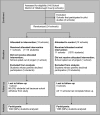Sun protection at elementary schools: a cluster randomized trial
- PMID: 20332388
- PMCID: PMC2902823
- DOI: 10.1093/jnci/djq010
Sun protection at elementary schools: a cluster randomized trial
Abstract
Background: Elementary schools represent both a source of childhood sun exposure and a setting for educational interventions.
Methods: Sun Protection of Florida's Children was a cluster randomized trial promoting hat use at (primary outcome) and outside of schools among fourth-grade students during August 8, 2006, through May 22, 2007. Twenty-two schools were randomly assigned to the intervention (1115 students) or control group (1376 students). Intervention schools received classroom sessions targeting sun protection attitudes and social norms. Each student attending an intervention school received two free wide-brimmed hats. Hat use at school was measured by direct observation and hat use outside of school was measured by self-report. A subgroup of 378 students (178 in the intervention group and 200 in the control group) underwent serial measurements of skin pigmentation to explore potential physiological effects of the intervention. Generalized linear mixed models were used to evaluate the intervention effect by accounting for the cluster randomized trial design. All P values were two-sided and were claimed as statistically significant at a level of .05.
Results: The percentage of students observed wearing hats at control schools remained essentially unchanged during the school year (baseline = 2%, fall = 0%, and spring = 1%) but increased statistically significantly at intervention schools (baseline = 2%, fall = 30%, and spring = 41%) (P < .001 for intervention effect comparing the change in rate of hat use over time at intervention vs control schools). Self-reported use of hats outside of school did not change statistically significantly during the study (control: baseline = 14%, fall = 14%, and spring = 11%; intervention: baseline = 24%, fall = 24%, and spring = 23%) nor did measures of skin pigmentation.
Conclusions: The intervention increased use of hats among fourth-grade students at school but had no effect on self-reported wide-brimmed hat use outside of school or on measures of skin pigmentation.
Figures


Comment in
-
Skin cancer prevention: sunnyside up or scrambled?J Natl Cancer Inst. 2010 Apr 7;102(7):445-7. doi: 10.1093/jnci/djq056. Epub 2010 Mar 23. J Natl Cancer Inst. 2010. PMID: 20332387 No abstract available.
References
-
- Jemal A, Siegel R, Ward E, et al. Cancer statistics, 2008. CA Cancer J Clin. 2008;58(2):71–96. - PubMed
-
- Miller D, Weinstock M. Nonmelanoma skin cancer in the United States: incidence. J Am Acad Dermatol. 1994;30(5 Pt 1):774–778. - PubMed
-
- Holman C, Armstrong B, Heenan P, et al. The causes of malignant melanoma: results from the West Australian Lions Melanoma Research Project. Recent results. Cancer Res. 1986;102:18–37. - PubMed
-
- Weinstock M, Colditz G, Willett W, et al. Nonfamilial cutaneous melanoma incidence in women associated with sun exposure before 20 years of age. Pediatrics. 1989;84(2):199–204. - PubMed
-
- Truhan AP. Sun protection in childhood. Clin Pediatr. 1991;30(12):676–681. - PubMed
Publication types
MeSH terms
Grants and funding
LinkOut - more resources
Full Text Sources
Medical

